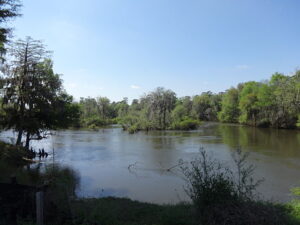The Flint River is entirely contained in the state of Georgia flowing from Atlanta to the Gulf of Mexico. It is 334 miles long and has a drainage area of 8,460 sq. miles all which is prone to flooding. In relation, it is one of the only rivers in the country to flow 200 miles without a dam. The river originates as groundwater seeps from the ground. This groundwater is created by the stormwater runoff from the impervious surfaces of the area. As it moves down south the river is sustained by high precipitation of the region which contributes to the floodplains of the middle section of the river. The lower section of the river is slower and narrow as the water is farther from the source. This is a great example of source to sink where precipitation runoff seeps into the groundwater and flows down from granite terrain, to floodplains, to swamps, and eventually to the ocean in the Gulf of Mexico.
The wetlands created from the Flint River are around 412,000 acres of swamps, flood plains, creeks, and springs. This river is used for energy, agriculture, impoundments, and municipal/industrial uses for its surrounding areas. The river also consists of three dams. Low flow of the river is a cause for concern as drought increases and various water demands become higher.
Being a large source of water in the area, the Flint River is known as the most diverse river drainages east of the Mississippi, and home to many species of fish (Shoal Bass, Halloween Darter, trout, catfish), mussels, and vegetation. Some species have been a result of human impact as rainbow and brown trout, white catfish, and flathead catfish have been introduced. The fish within the river is used to feed the area which has been concerned with the increased amount of overfishing. Like most rivers the vegetation of the river is dense. Being in Georgia, trees like magnolias, cypresses, and sycamores can be found within the area of the river.
Looking into the future, the Flint River may be at risk. As the population grows, water and food demands become greater. Human impact and rising temperatures may result in the shrinking and slower flow of the river. This is detrimental to the fragile ecosystems and other geological features of the area making it a high priority area for sustainability and conservation.

American Rivers. (2019, May 15). Flint river Georgia . American Rivers. Retrieved December 1, 2021, from https://www.americanrivers.org/river/flint-river/.
Georgia River Network. (2021, February 16). Flint river. Georgia River Network. Retrieved December 1, 2021, from https://garivers.org/flint-river/.
Hicks, D., & Opsahl, S. (n.d.). Sherpa guides: Georgia: The natural Georgia series: The Flint River: The natural history of the Flint River. Sherpa Guides | Georgia | The Natural Georgia Series | The Flint River | The Natural History of the Flint River. Retrieved December 1, 2021, from https://www.sherpaguides.com/georgia/flint_river/natural_history/index.html.
Wikimedia Foundation. (2021, September 25). Flint river (Georgia). Wikipedia. Retrieved December 1, 2021, from https://en.wikipedia.org/wiki/Flint_River_(Georgia).